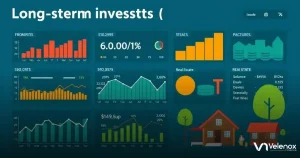Dividend-paying stocks USA are becoming increasingly attractive for investors looking for passive income.
These financial instruments not only provide regular financial returns but also signify a company’s reliability and stability.
Understanding Dividend-Paying Stocks
Understanding dividend-paying stocks is key for anyone interested in investing.
These stocks are shares in companies that return a portion of their profits to shareholders as dividends.
This is like a reward for owning a piece of the company. The more shares you have, the larger your dividend payment can be.
Investors often seek out dividend-paying stocks because they provide a steady income stream.
As companies make profits, they can choose to share that money with their investors.
For many people, this regular income can help pay bills or reinvest into more stocks.
Dividend payments can also indicate a company’s financial health and stability.
When looking for the best dividend-paying stocks in the USA, it’s important to research companies that have a history of paying consistent and increasing dividends.
These are signals of strong management and a profitable business.
Investors should also consider the dividend yield, which shows how much a company pays out in dividends relative to its stock price.
This helps in understanding how much return you can expect from your investment.
Benefits of Investing in Dividend Stocks
Investing in dividend stocks offers several benefits that can help grow your wealth.
One major advantage is the steady income that these stocks provide.
Regular dividend payments can offer a reliable cash flow, which is especially helpful for retirees or anyone looking for consistent income.
This regular income can be used for everyday expenses or reinvested to buy more shares and increase future earnings.
Another important benefit is that dividend stocks can be a sign of a company’s health and stability.
Companies that consistently pay dividends often have strong financials and a solid business plan.
This makes them attractive options for investors looking for safer investment opportunities.
The assurance that your investment comes from a company that values returning profits to its shareholders can be very encouraging.
Lastly, dividend-paying stocks can provide some protection against market volatility.
Even when stock prices dip, investors can still earn dividends. This can help cushion the blow during a downturn.
Additionally, many dividend stocks tend to appreciate in value over time, offering potential capital gains alongside dividend payouts.
This combination makes dividend stocks a great option for income investors.
How to Identify Top Dividend Stocks
Identifying top dividend stocks starts with looking at a company’s dividend yield.
This number shows how much a company pays out in dividends compared to its stock price.
A higher yield can indicate that a stock is a good option for income.
However, be careful with stocks that have extremely high yields, as they might be risky.
It’s important to research why the yield is high and whether the company can keep paying dividends over time.
Another key factor to consider is the company’s dividend history.
Look for companies that have consistently paid dividends over the years and even increased them.
This track record shows that the company is stable and committed to rewarding its shareholders.
A company that regularly raises its dividends can be a strong sign of growth potential, making it a top pick for your portfolio.
Finally, you should examine the overall health of the company. Check its earnings reports and assess whether it has strong cash flow and low debt.
Companies with a solid financial foundation are usually better at maintaining their dividend payments, even during tough times.
Analyzing these factors can help you confidently identify the best dividend-paying stocks for your investment goals.
The Best Dividend-Paying Stocks in the USA

The best dividend-paying stocks in the USA are typically large, well-established companies that have a history of strong financial performance.
Some popular examples include companies like Johnson & Johnson and Procter & Gamble.
These companies are known for their reliable dividends and have consistently increased payments over the years.
Investing in these stocks can help you earn a steady income while benefiting from their growth.
Another great choice includes utility companies such as Duke Energy and Southern Company.
These firms provide essential services and often have steady profits, making them reliable dividend payers.
Utility companies tend to perform well even during economic downturns, giving investors peace of mind with their dividends.
Finally, don’t forget about financial companies like JPMorgan Chase or Bank of America.
These banks have a track record of paying dividends and are involved in diverse financial services.
As the economy recovers, these institutions often see increased profits, allowing them to maintain or even raise their dividend payments, benefiting their shareholders.
Tips for Building a Dividend Portfolio
Building a dividend portfolio starts with selecting a diverse range of stocks.
Including companies from different sectors, like healthcare, utilities, and finance, can spread risk.
This way, if one sector is struggling, others may perform well and keep your overall income steady.
Look for companies with strong histories of paying and increasing dividends, as these can provide reliable income over time.
Another crucial tip is to pay attention to dividend reinvestment. By reinvesting your dividends, you can buy more shares and grow your portfolio faster.
This compounding effect can significantly increase your earnings over time.
Many brokers offer automatic reinvestment plans, making it easy to steadily increase your investment without extra effort.
Finally, keep an eye on your portfolio and review it regularly. As companies change and the market shifts, your investments may need adjustments.
Make sure to monitor the health of your dividend stocks and be ready to replace any underperforming ones.
Staying informed will help you maintain a strong dividend portfolio that meets your income goals.
Risks Associated with Dividend Stocks
Investing in dividend stocks carries certain risks that investors should be aware of before committing their money.
One major risk is the potential for dividend cuts. Companies may reduce or eliminate their dividend payments if they face financial struggles or economic downturns.
This can hit your income significantly, especially if you rely on those dividends for regular cash flow.
Another risk to consider involves market fluctuations. Dividend stocks can still be affected by stock market volatility.
If the market drops, even strong companies can see their stock prices decline sharply, impacting your overall investment value.
While you may still receive dividends, the decrease in stock price can be discouraging and may affect your investment strategy.
Lastly, inflation can erode the purchasing power of your dividend income.
If dividends do not increase at a rate that outpaces inflation, you may find that your income buys less over time.
It’s important to invest in companies that not only provide dividends but also have a history of increasing their payouts to somewhat keep up with inflation trends.
Analyzing Dividends: What to Look For
Analyzing dividends is an important step in choosing the right stocks for your portfolio. One of the first things to look for is the dividend yield.
This figure shows how much a company pays out in dividends relative to its stock price.
A higher yield can indicate a solid income opportunity, but it’s important to consider the company’s ability to maintain that yield over time.
Next, you should examine the company’s history of dividend payments.
Look for companies that have consistently paid and increased their dividends for many years.
This track record can be a strong sign of financial stability and a commitment to returning profits to shareholders.
Companies that are known for growing their dividends are often good long-term investments.
Finally, consider the payout ratio when analyzing dividends. This ratio shows what portion of a company’s earnings is paid out as dividends.
A lower payout ratio means the company retains more earnings for growth, while a very high ratio could indicate risk if earnings fall.
A balance between a healthy payout ratio and strong earnings growth can lead to a sustainable dividend strategy.
Tax Implications of Dividend Stocks

Tax implications of dividend stocks can greatly affect your investment returns.
In the USA, dividend-paying stocks USA are generally taxed as ordinary income, unless they qualify as qualified dividends with lower tax rates.
This means that your dividend income is added to your total income and taxed at your regular income tax rate.
It’s important to consider how much tax you may owe when calculating the net income from your dividends.
However, qualified dividends are treated differently for tax purposes.
These dividends come from stocks held for a certain period and can be taxed at lower capital gains rates instead of ordinary income rates.
To enjoy this tax benefit, it’s essential to meet the holding period requirements for the stocks you own, which can help maximize your after-tax income from dividends.
It’s also important to keep track of the type of dividends you receive throughout the year.
Some dividends may be subject to special taxes, like the Net Investment Income Tax for higher earners.
Understanding these tax implications can help you make informed decisions about which dividend stocks to include in your portfolio and how to manage your tax liabilities effectively.
Future Trends in Dividend Investing
Future trends in dividend investing are likely to be influenced by changing economic conditions and investor preferences.
Dividend-paying stocks USA may continue gaining popularity as investors seek stable returns in uncertain markets.
One major trend is the growing interest in sustainability and socially responsible investing.
Investors are increasingly looking for dividend-paying companies that align with their values, such as those prioritizing environmental, social, and governance (ESG) factors.
As more investors seek to support companies that contribute positively to society, businesses that meet these criteria may see stronger demand for their stocks.
Another trend is the rise of technology and innovation in finance.
With advancements in data analysis and investment platforms, investors now have access to tools that can help them identify top dividend stocks more easily.
This technology allows for better tracking and analysis of dividend performance, enabling investors to make informed decisions quickly.
The emergence of robo-advisors also offers automated investment strategies focused on generating income through dividends.
Finally, as the economy evolves, unprecedented market conditions may lead to changes in how companies approach dividends.
For example, companies may shift toward more flexible dividend policies, allowing them to adapt to economic fluctuations.
Investors should remain aware of these changes, as company strategies can impact dividend reliability and overall investment returns.
Staying informed about these future trends can help investors position their portfolios for long-term success.





